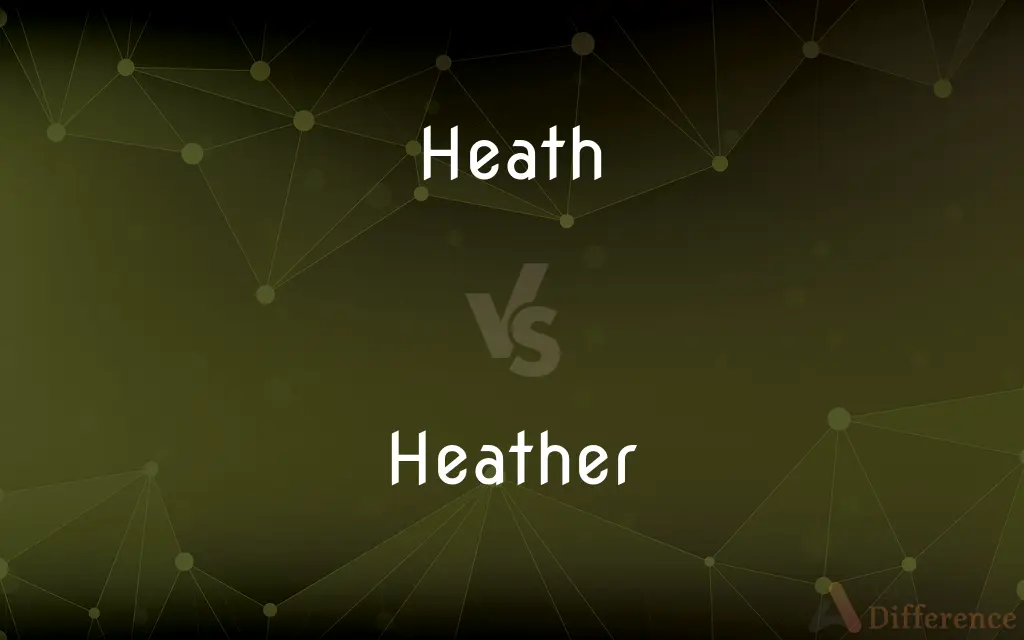Heath vs. Heather — What's the Difference?
Edited by Tayyaba Rehman — By Fiza Rafique — Updated on April 21, 2024
Heath refers to a tract of open and uncultivated land with poor soil and low shrubs, whereas heather is a small shrub with pink or purple flowers common on heaths.

Difference Between Heath and Heather
Table of Contents
ADVERTISEMENT
Key Differences
Heath describes a type of landscape characterized by open, uncultivated land often found in poor soil areas, supporting mainly low-growing shrubby vegetation. Whereas, heather specifically refers to the evergreen flowering plants that commonly grow in these heathlands. Both terms are often associated with each other, yet they represent different aspects of the same environment.
Heathlands are ecosystems defined more by their geographical and ecological conditions, including soil type and climate. On the other hand, heather is a botanical term, denoting certain species of the genus Calluna or Erica, which are adapted to grow in the acidic soil of heathlands.
Heath is a broader ecological concept, encompassing not only the vegetation but also the type of soil and the overall landscape. Whereas heather focuses specifically on the plant species, which are characteristic of heathlands and are known for their resilience and ability to thrive in challenging conditions.
Conservation efforts for heath environments often focus on preserving the unique biodiversity and preventing the land from being overtaken by forest or agricultural use. On the other hand, heather is often managed within these heathlands to ensure its survival, reflecting its importance as a habitat for various wildlife species.
Tourism in regions known for their heathlands often celebrates both the scenic beauty of these open landscapes and the iconic appearance of heather, especially when it blooms in late summer. Whereas the appeal of heather lies not only in its aesthetic contribution but also in its role in traditional crafts and uses, such as in making honey.
ADVERTISEMENT
Comparison Chart
Definition
Open, uncultivated land with poor soil and shrubs
A small flowering shrub with pink or purple blooms
Ecological Role
Provides habitat for various wildlife; indicates poor soil quality
Prominent in heathlands, important for biodiversity
Conservation Focus
Landscape preservation and biodiversity protection
Plant species preservation and management
Aesthetic Appeal
Valued for rugged natural beauty
Appreciated for colorful blooms and landscape contribution
Usage
Often referred to in a geographical or ecological context
Used in gardening, decorative crafts, and honey production
Compare with Definitions
Heath
A term used to describe habitats with particular ecological characteristics such as low fertility and open access.
Conservationists are focused on preserving the natural state of the heath.
Heather
Belongs to the genus Calluna or Erica.
Gardeners favor heather for its hardiness and year-round appeal.
Heath
A tract of open uncultivated land; usually with sandy soil and scrubby vegetation.
The hikers traversed the sprawling heath under the open sky.
Heather
Used decoratively in gardens and landscapes for its aesthetic appeal and resilience.
He planted heather along the walkway for a splash of color.
Heath
An area of land that has not been cultivated due to its poor soil quality.
Despite its barren appearance, the heath was teeming with wildlife.
Heather
A small evergreen shrub with dense, flower-laden branches.
The heather was in full bloom, painting the hills purple.
Heath
A landscape type found typically in cooler climates characterized by specific soil and vegetation.
The heath was covered with a blanket of frost in the early morning.
Heather
Harvested for traditional uses, including making honey and in crafts.
The local honey, made primarily from heather, was renowned for its unique flavor.
Heath
Often associated with the presence of heather and similar plants.
In summer, the heath was a popular spot for viewing the blooming heather.
Heather
Commonly found in moorland environments where it forms a significant part of the ecosystem.
Bees buzzed busily around the patches of heather.
Heath
A heath () is a shrubland habitat found mainly on free-draining infertile, acidic soils and characterised by open, low-growing woody vegetation. Moorland is generally related to high-ground heaths with—especially in Great Britain—a cooler and damper climate.
Heather
A low-growing Eurasian shrub (Calluna vulgaris) in the heath family, growing in dense masses and having small evergreen leaves and clusters of small, bell-shaped pinkish-purple flowers. Also called ling2.
Heath
Any of various usually low-growing shrubs of the genus Erica and other genera of the heath family, native to Europe and South Africa and having small evergreen leaves and small, colorful, urn-shaped flowers. Also called heather.
Heather
See heath.
Heath
An extensive tract of uncultivated open land covered with herbage and low shrubs; a moor.
Heather
A grayish purple to purplish red.
Heath
A tract of level uncultivated land with sandy soil and scrubby vegetation; heathland.
Heather
An evergreen plant, Calluna vulgaris, with spiky leaves and small purple, pink, or white flowers.
Heath
Any small evergreen shrub of the family Ericaceae.
Heather
A plant in the family Ericaceae.
Heath
Many of the species in the genus Erica
Heather
Various species of the genus Erica.
Heath
Many of the species in the genus Cassiope
Heather
Various species of the genus Cassiope.
Heath
Both species in the genus Daboecia
Heather
A purple colour with a tint of pink and blue.
Heath
Any of the species in the genus Epacris, Australian heath
Heather
(textiles) The use of interwoven yarns of mixed colours to produce flecks.
Heath
Any of the species in the genus Leucopogon, beard heath
Heather
Of a purple colour with a tint of pink and blue.
Heath
Any of the species in the genus Phyllodoce, mountain heath
Heather
Heath.
Gorse and grassAnd heather, where his footsteps pass,The brighter seem.
Heath
(countable) Certain butterflies and moths
Heather
Common Old World heath represented by many varieties; low evergreen grown widely in the northern hemisphere
Heath
The palearctic species of Coenonympha, a genus of brush-footed butterfly
Heather
Interwoven yarns of mixed colors producing muted grayish shades with flecks of color
Heath
Melitaea athalia, the heath fritillary
Heath
Semiothisa clathrata, a moth known as the latticed heath
Heath
A low shrub (Erica vulgaris or Calluna vulgaris), with minute evergreen leaves, and handsome clusters of pink flowers. It is used in Great Britain for brooms, thatch, beds for the poor, and for heating ovens. It is also called heather, and ling.
Heath
A place overgrown with heath; any cheerless tract of country overgrown with shrubs or coarse herbage.
Their stately growth, though bare,Stands on the blasted heath.
Heath
A low evergreen shrub of the family Ericaceae; has small bell-shaped pink or purple flowers
Heath
A tract of level wasteland; uncultivated land with sandy soil and scrubby vegetation
Common Curiosities
How are heaths threatened by human activity?
Heaths are threatened by urban development, agricultural expansion, and the planting of non-native trees, which can alter the soil and ecological balance.
What species are typically found in a heath?
Heaths typically host a variety of low shrubs, including heather, gorse, and various mosses and grasses.
What is the best time of year to see heather in bloom?
Heather typically blooms from late summer to early autumn, with peak flowering occurring in August and September.
Is heather evergreen or deciduous?
Heather is generally evergreen, maintaining its foliage throughout the year.
How do heaths benefit the ecosystem?
Heaths are important for biodiversity, providing habitats for numerous bird species, insects, and reptiles, and playing a role in soil conservation.
How does heather contribute to soil health?
Heather helps to stabilize soil, reduce erosion, and add organic matter as its leaves decompose, which benefits the nutrient-poor soils typically found in heathlands.
How does climate change affect heathlands?
Climate change affects heathlands by altering rainfall patterns and temperatures, potentially leading to changes in vegetation and increased vulnerability to invasive species.
What wildlife is particularly associated with heather?
Heather provides food and shelter for various wildlife, including bees, butterflies, birds, and deer.
Can heather be used in home gardening?
Yes, heather is popular in home gardening due to its attractive flowers, evergreen foliage, and low maintenance requirements.
What are the soil requirements for heather?
Heather requires well-drained, acidic soil and does not thrive in alkaline or overly wet conditions.
Can heather be found outside of heathlands?
While heather is typical of heathlands, it can also be found in other habitats like moorlands, coastal areas, and in gardens as cultivated varieties.
How can heathlands be conserved?
Conservation of heathlands involves managing encroachment by trees, preventing overgrazing, and conducting controlled burns to maintain the open landscape.
What are the challenges in growing heather?
The main challenges include ensuring acidic soil conditions, avoiding waterlogged areas, and protecting from extreme cold without snow cover.
What cultural significance does heather have?
Heather has cultural significance in Scotland and other parts of Europe, symbolizing admiration, protection, and solitude.
How are heath and heather similar and different in their ecological roles?
Both heath and heather contribute to biodiversity; however, heath refers to the entire ecosystem, whereas heather is a specific plant within that ecosystem that plays a critical role in maintaining the ecological balance.
Share Your Discovery

Previous Comparison
Infantry vs. Airborne
Next Comparison
Capital vs. PrincipalAuthor Spotlight
Written by
Fiza RafiqueFiza Rafique is a skilled content writer at AskDifference.com, where she meticulously refines and enhances written pieces. Drawing from her vast editorial expertise, Fiza ensures clarity, accuracy, and precision in every article. Passionate about language, she continually seeks to elevate the quality of content for readers worldwide.
Edited by
Tayyaba RehmanTayyaba Rehman is a distinguished writer, currently serving as a primary contributor to askdifference.com. As a researcher in semantics and etymology, Tayyaba's passion for the complexity of languages and their distinctions has found a perfect home on the platform. Tayyaba delves into the intricacies of language, distinguishing between commonly confused words and phrases, thereby providing clarity for readers worldwide.















































